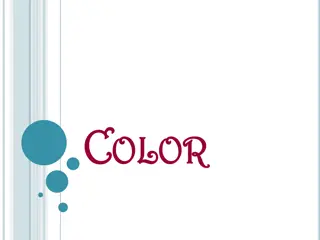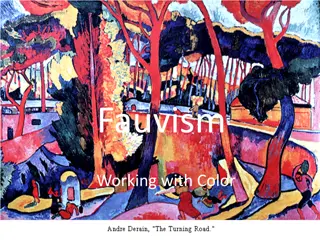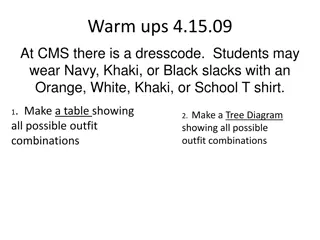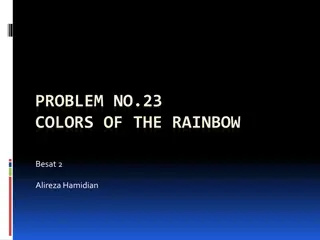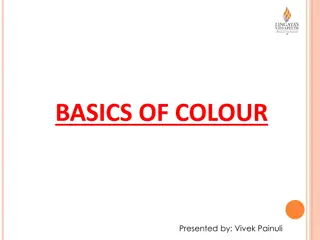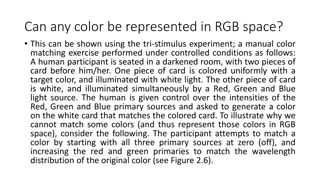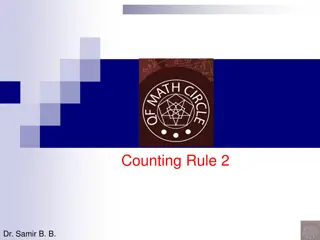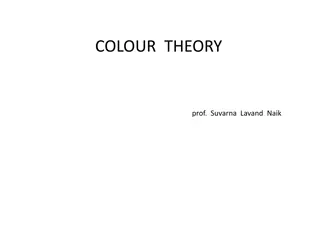Understanding Color Theory: A Comprehensive Guide to Colors
Explore the fascinating world of colors with an in-depth look into color theory. Learn about chromatic and achromatic colors, neutral colors, hues, color wheels, primary and secondary colors, tertiary colors, values, tints, shades, and tones. Delve into the visual responses of the eye to reflected r
2 views • 19 slides
30 Amazing Wall Colour Combinations for a Living Room To Take Inspiration From
Considering that your living room is the first part of your home that guests will see, the wall colour combination for the living room should be perfect to set the tone for the rest of your space. Here are some amazing wall colour combinations for a living room that you can take inspiration from:\n\
1 views • 33 slides
Salwar Suit Color Combinations for Different Events
Choosing the appropriate color scheme for your salwar suit can have a big impact on how you feel and look at different occasions. Regardless of the occasion\u2014wedding, festival, get-together, formal event, or engagement\u2014these color combinatio
0 views • 2 slides
Color Accessibility Guidelines and Examples
Enhance color accessibility in presentations by following Louisiana Tech University's guidelines for using brand colors, text sizes, and color combinations. Learn how to create visually inclusive content and promote readability for all audiences. Explore approved color palettes and typography recomm
2 views • 11 slides
Fun Art Task: Creating a Color Wheel
Explore color relationships by mixing secondary and tertiary colors to create a vibrant color wheel. Learn about primary, secondary, and tertiary colors, and follow step-by-step instructions to create your own color wheel using basic art supplies. Enhance your understanding of color theory through t
1 views • 12 slides
Understanding Temperature and Color Relationship in Candle Flames
Explore the relationship between temperature and color in candle flames through the three zones model. By conducting experiments using a thermocouple sensor, investigate how the color gradient in a flame correlates with its temperature variations. Learn about the structure of a candle flame, the inf
1 views • 21 slides
Understanding Combinations and Probability in Statistics
Explore the concept of combinations and probability in statistics with a focus on calculating the number of ways to choose individuals from a group without considering order. Learn how to compute combinations, apply counting principles, and solve practical examples to deepen your understanding.
0 views • 18 slides
Limit Test of Iron Based on Color Reaction with Thioglycollic Acid
The limit test for iron involves the reaction of iron in ammoniacal solution with citric acid and thioglycollic acid to form a reddish-purple color. By comparing the color produced with a standard solution, the presence of iron is determined. Citric acid prevents precipitation of iron, while thiogly
1 views • 5 slides
Mastering Color in Film: A Comprehensive Guide to Using Color Grading Techniques
Explore the intricate world of color in filmmaking through understanding color grading, log explained, Log rec.709, color correction, and grading techniques without LUTs. Enhance your storytelling by harnessing the power of color to evoke emotions and create visual impact in your films.
1 views • 6 slides
Combinations and Probability in Statistics
Explore the concept of combinations and probability in statistics through lessons covering the computation of combinations, use of combinations to calculate probabilities, and application of the multiplication counting principle. Understand how to determine the number of different sets of selections
0 views • 17 slides
Understanding Color Theory: A Visual Guide for Effective Communication
Explore the fundamentals of color theory, from primary to tertiary colors, and how they can be combined to achieve aesthetic blends, readability, and convey meaning. Discover the role of the color wheel in making purposeful color selections for creating visual impact and contrast in design and commu
0 views • 21 slides
Exploring Color Superposition in Everyday Life
Dive into a fascinating exploration of color superposition in everyday life through the lens of primary colors and their combinations. Learn how our understanding of colors can vary based on our perception and knowledge, leading to intriguing insights about the nature of color itself.
0 views • 27 slides
IEEE 802.11-19/1907r2 Multiple RU Combinations for EHT
11be task group approved multiple RU combinations for PPDU BW up to 160MHz. Principles outlined to limit combined RUs, focusing on spectrum use enhancement. Useful scenarios discussed for small-size RU combinations within 20MHz and 40MHz bands. Considerations highlighted regarding combining differen
0 views • 32 slides
Multiple RU Combinations for Enhanced High Throughput (EHT) in IEEE 802.11-19/1907r0
The document discusses the introduction and design principles for multiple RU combinations in the context of IEEE 802.11-19/1907r0. It explores the considerations and useful scenarios of small-size RU combinations within specified bandwidths, emphasizing the efficiency and complexity balance in the
0 views • 19 slides
Understanding Fauvism: Working with Colors and Color Schemes
Fauvism is an art movement known for its bold and arbitrary use of colors. Fauvist painters carefully selected colors to convey specific moods in their artworks. This guide explores Fauvism, color theory, and different color schemes to help you create your own expressive painting. Learn about comple
0 views • 8 slides
Understanding Color Theory: A Comprehensive Guide
Practical guidance on color theory including the color wheel, color schemes, and color psychology. Learn about the importance of utilizing various color schemes like monochromatic, complementary, and analogous to create effective designs. Understand how different colors convey meanings and emotions
0 views • 11 slides
Understanding Color: Characteristics, Color Wheel, and Interior Decoration
Color is a vital aspect of our everyday lives, evoking various emotions and perceptions. This article delves into the characteristics of color, the color wheel, color schemes, and the use of color in interior decoration. It explains how colors are perceived, the qualities of color like hue, value, a
1 views • 51 slides
Fun and Educational Color Mixing Experiment for Elementary Students
Engage elementary school students in a hands-on color mixing experiment using primary colors to create secondary colors. The activity involves visual demonstrations, color paddles, and mixing colored goo in bags to understand color blending and create unique color combinations. Through this interact
0 views • 7 slides
Enhancing Safety through Systematic Hazard Combinations Analysis in NPP Design Basis & PSA at NPP Paks
In this preparatory study, Tamas Siklossy, Attila Bareith, and Barnabas Toth discuss the importance of considering hazard combinations in the design basis and PSA of the Paks NPP in Hungary. The study reviews current practices, outlines technical tasks, and emphasizes the need to assess the impact o
0 views • 17 slides
Dress the Elf: Exploring Clothing Combinations
Discover the fun Dress-the-Elf activity where you work out the number of possible clothing combinations for an adorable elf character. Follow the steps to color, design, cut, and stick the elf's clothes to create various looks. Learn how to use multiplication to calculate the different dressing opti
0 views • 5 slides
Fashion Dress Code Combinations and Mathematical Tables
Explore the dress code combinations for a school and delve into mathematical tables related to the area, circumference of a circle, and the volume of a cube. The content includes creating tables and tree diagrams for outfit combinations and presenting mathematical formulas in tabular form.
0 views • 4 slides
Probability and Linear Combinations in Statistics
Delve into a thought-provoking journey of solving probability games and applying linear combinations in statistics. You will explore creating probability distributions, calculating expected values, and understanding the rules of linear combinations through engaging examples and practice problems. Di
0 views • 23 slides
Understanding Combinations and Counting Techniques
Combinations play a crucial role in counting techniques, where subsets of elements are selected without regard for the order. This text explores the concept of combinations, including calculating the number of possible combinations, distinguishing between unordered and ordered selections, and provid
0 views • 11 slides
Understanding Attributes and Color Schemes in Graphics
Graphics systems utilize attributes to define how primitives are displayed, such as color and size, while color and grayscale can be stored in different ways like direct storage and indexed storage schemes. The RGB color components play a key role in determining the color shades, with various color
0 views • 51 slides
Understanding Intangible Assets and Business Combinations in Accounting
In accounting, recognition of intangible assets as assets requires the expectation of future economic benefits flowing to the entity and reliable measurement of the asset's cost. Intangible assets acquired separately are recognized based on their fair value, while those acquired in business combinat
1 views • 23 slides
Permutations and Combinations Problem Set
Explore various permutations and combinations scenarios involving arranging items in a particular order or selecting items where order does not matter. Topics covered include choosing lunch items, possible license plate combinations, arranging shirts in a closet, selecting students for presentations
0 views • 6 slides
Understanding Color: A Comprehensive Overview
Color is a fascinating aspect of our visual world, explored through the prism of science and light. This chapter delves into the origins of color perception, from Isaac Newton's study of the color spectrum to the reflection and transmission of light that determines how we see colors. Gain insights i
0 views • 28 slides
Understanding Color Blindness: Causes, Symptoms, and Types
Color blindness, also known as color vision deficiency, is a genetic disorder that affects the ability to distinguish between certain colors. It is caused by the absence of color-sensitive pigment in cone cells of the retina, often passed down on the X chromosome. Symptoms vary from difficulty diffe
1 views • 16 slides
Exploring Color Combinations with Chemical Reactions
Explore various color combinations using aqueous solutions of potassium dichromate, copper sulfate, and other colorless solutions. By mixing these solutions, generate distinct colors in test tubes through chemical reactions. Different hues such as yellow, blue, orange, light purple, and green are ac
0 views • 6 slides
The Impact of Colors on Decision Making in Visual Displays
Investigating the influence of color on decision-making, particularly in legal contexts, through the manipulation of photographs with different color schemes. Prior research suggests that color can play a crucial role in how visuals are perceived and remembered, especially in litigation settings. By
0 views • 37 slides
Exploring the Basics of Color Theory
Understand the essence of color with insights into the sources, perception, and interpretation of color. Dive into the color wheel, primary, secondary, tertiary, warm, cool, and neutral colors, and learn about color harmony to create visually pleasing designs.
0 views • 14 slides
Understanding Color Representation: RGB vs. CIE vs. HSV Models
Exploring the limitations of representing all colors in RGB space and the alternative approaches offered by the CIE color space and HSV color model. While RGB is limited by additive primaries, CIE provides a broader range of color representation, and HSV simplifies color perception by emphasizing hu
0 views • 8 slides
Understanding Color Blindness: Types, History, and Impacts
Color blindness, also known as color vision deficiency, affects individuals by limiting their ability to perceive certain colors. It was first discovered by John Dalton, who suffered from red/green color blindness himself. The two main types are red/green and blue/yellow color blindness, each with i
0 views • 19 slides
Understanding Color Blindness: Causes, Symptoms, and Diagnosis
Color blindness, also known as color vision deficiency, is a genetic disorder that affects the ability to distinguish between colors. John Dalton discovered color blindness in 1794. It is inherited in an X-linked recessive pattern and can cause difficulties in daily life, such as trouble seeing colo
0 views • 13 slides
Understanding Design Principles: Contrast, Repetition, Alignment, Proximity, Color Theory
Explore the significance of design principles such as contrast, repetition, alignment, proximity, and color theory in creating visually appealing and effective designs. Learn how contrast plays a vital role in guiding the viewer's attention and enhancing visual interest through various techniques li
0 views • 30 slides
Understanding Permutations and Combinations in Mathematics
Permutations and combinations are fundamental concepts in mathematics that test logical reasoning and problem-solving skills. This article covers the basics of permutations, combinations, factorial, fundamental counting principles, and example questions to help you grasp these concepts effectively.
0 views • 86 slides
A New Combinatorial Gray Code for Balanced Combinations
This research work by Torsten Mütze, Christoph Standke, and Veit Wiechert introduces a new combinatorial Gray code for balanced combinations, focusing on a-element subsets and flaws in Dyck path representation. The study explores various aspects of balanced combinations, their flaws, and the relati
0 views • 30 slides
Understanding Counting Methods: Combinations and Permutations
This content discusses various counting methods for computing probabilities, focusing on combinations and permutations. It explains the concepts of combinations (order doesn't matter) and permutations (order matters) with examples of selection and arrangement scenarios. The distinction between with
0 views • 37 slides
Exploring the Impact of Color in Film Studies
Delve into the fascinating world of color in films through a series of engaging activities and discussions. From black and white classics to vibrant modern movies, uncover how color choices influence storytelling, evoke emotions, and captivate audiences. Explore the history, science, and psychology
0 views • 6 slides
Understanding Color Theory: Basics and Applications
Color theory encompasses the color wheel, color harmony, and how colors are used. It provides a logical structure for organizing and creating colors. Primary, secondary, and tertiary colors play key roles in this theory, along with concepts like color harmony and context. By understanding color theo
0 views • 28 slides
